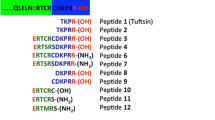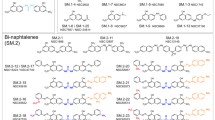Abstract
The peptides N-tert-butyloxycarbonyl-Phe-Leu-Phe-Leu-Phe (BOC2) and BOC-Met-Leu-Phe (BOC1) are widely used antagonists of formyl peptide receptors (FPRs), BOC2 acting as an FPR1/FPR2 antagonist whereas BOC1 inhibits FPR1 only. Extensive investigations have been performed by using these FPR antagonists as a tool to assess the role of FPRs in physiological and pathological conditions. Based on previous observations from our laboratory, we assessed the possibility that BOC2 may exert also a direct inhibitory effect on the angiogenic activity of vascular endothelial growth factor-A (VEGF-A). Our data demonstrate that BOC2, but not BOC1, inhibits the angiogenic activity of heparin-binding VEGF-A165 with no effect on the activity of the non-heparin-binding VEGF-A121 isoform. Endothelial cell-based bioassays, surface plasmon resonance analysis, and computer modeling indicate that BOC2 may interact with the heparin-binding domain of VEGF-A165, thus competing for heparin interaction and preventing the binding of VEGF-A165 to tyrosine kinase receptor VEGFR2, its phosphorylation and downstream signaling. In addition, BOC2 inhibits the interaction of a variety of heparin-binding angiogenic growth factors with heparin, including fibroblast growth factor 2 (FGF2) whose angiogenic activity is blocked by the compound. Accordingly, BOC2 suppresses the angiogenic potential of human tumor cell lines that co-express VEGF-A and FGF2. Thus, BOC2 appears to act as a novel multi-heparin-binding growth factor antagonist. These findings caution about the interpretation of FPR-focusing experimental data obtained with this compound and set the basis for the design of novel BOC2-derived, FPR independent multi-target angiogenesis inhibitors.






Similar content being viewed by others
References
Carmeliet P (2003) Angiogenesis in health and disease. Nat Med 9:653–660
Witmer AN, Vrensen GF, Van Noorden CJ, Schlingemann RO (2003) Vascular endothelial growth factors and angiogenesis in eye disease. Prog Retin Eye Res 22:1–29
Elshabrawy HA, Chen Z, Volin MV, Ravella S, Virupannavar S, Shahrara S (2015) The pathogenic role of angiogenesis in rheumatoid arthritis. Angiogenesis 18:433–448
Seabrook TJ, Littlewood-Evans A, Brinkmann V, Pollinger B, Schnell C, Hiestand PC (2010) Angiogenesis is present in experimental autoimmune encephalomyelitis and pro-angiogenic factors are increased in multiple sclerosis lesions. J Neuroinflammation 7:95
Weis SM, Cheresh DA (2011) Tumor angiogenesis: molecular pathways and therapeutic targets. Nat Med 17:1359–1370
Bergers G, Benjamin LE (2003) Tumorigenesis and the angiogenic switch. Nat Rev Cancer 3:401–410
Jayson GC, Kerbel R, Ellis LM, Harris AL (2016) Antiangiogenic therapy in oncology: current status and future directions. Lancet 388:518–529
Chiodelli P, Bugatti A, Urbinati C, Rusnati M (2015) Heparin/Heparan sulfate proteoglycans glycomic interactome in angiogenesis: biological implications and therapeutical use. Molecules 20:6342–6388
Koch S, Claesson-Welsh L (2012) Signal transduction by vascular endothelial growth factor receptors. Cold Spring Harb Perspect Med 2:a006502
Presta M, Dell’Era P, Mitola S, Moroni E, Ronca R, Rusnati M (2005) Fibroblast growth factor/fibroblast growth factor receptor system in angiogenesis. Cytokine Growth Factor Rev 16:159–178
Leali D, Belleri M, Urbinati C, Coltrini D, Oreste P, Zoppetti G et al (2001) Fibroblast growth factor-2 antagonist activity and angiostatic capacity of sulfated Escherichia coli K5 polysaccharide derivatives. J Biol Chem 276:37900–37908
Rezzola S, Dal Monte M, Belleri M, Bugatti A, Chiodelli P, Corsini M et al (2015) Therapeutic potential of anti-angiogenic multitarget N, O-sulfated E. coli K5 polysaccharide in diabetic retinopathy. Diabetes 64:2581–2592
Koch S, Tugues S, Li X, Gualandi L, Claesson-Welsh L (2011) Signal transduction by vascular endothelial growth factor receptors. Biochem J 437:169–183
Teran M, Nugent MA (2015) Synergistic binding of vascular endothelial growth factor-A and its receptors to heparin selectively modulates complex affinity. J Biol Chem 290:16451–16462
Toniolo C, Bonora GM, Showell H, Freer RJ, Becker EL (1984) Structural requirements for formyl homooligopeptide chemoattractants. Biochemistry 23:698–704
Prevete N, Liotti F, Marone G, Melillo RM, de Paulis A (2015) Formyl peptide receptors at the interface of inflammation, angiogenesis and tumor growth. Pharmacol Res 102:184–191
Lee HY, Lee M, Bae YS (2017) Formyl peptide receptors in cellular differentiation and inflammatory diseases. J Cell Biochem 118:1300–1307
Rezzola S, Corsini M, Chiodelli P, Cancarini A, Nawaz IM, Coltrini D et al (2017) Inflammation and N-formyl peptide receptors mediate the angiogenic activity of human vitreous humour in proliferative diabetic retinopathy. Diabetologia 60:719–728
Simo R, Carrasco E, Garcia-Ramirez M, Hernandez C (2006) Angiogenic and antiangiogenic factors in proliferative diabetic retinopathy. Curr Diabetes Rev 2:71–98
Wang S, Park JK, Duh EJ (2012) Novel targets against retinal angiogenesis in diabetic retinopathy. Curr Diab Rep 12:355–363
Dai Y, Wu Z, Wang F, Zhang Z, Yu M (2014) Identification of chemokines and growth factors in proliferative diabetic retinopathy vitreous. Biomed Res Int 2014:486386
Bandello F, Lattanzio R, Zucchiatti I, Del Turco C (2013) Pathophysiology and treatment of diabetic retinopathy. Acta Diabetol 50:1–20
Tanghetti E, Ria R, Dell’Era P, Urbinati C, Rusnati M, Ennas MG, Presta M (2002) Biological activity of substrate-bound basic fibroblast growth factor (FGF2): recruitment of FGF receptor-1 in endothelial cell adhesion contacts. Oncogene 21:3889–3897
Kimmel CB, Ballard WW, Kimmel SR, Ullmann B, Schilling TF (1995) Stages of embryonic development of the zebrafish. Dev Dyn 203:253–310
Nicoli S, De Sena G, Presta M (2009) Fibroblast growth factor 2-induced angiogenesis in zebrafish: the zebrafish yolk membrane (ZFYM) angiogenesis assay. J Cell Mol Med 13:2061–2068
Nicoli S, Presta M (2007) The zebrafish/tumor xenograft angiogenesis assay. Nat Protoc 2:2918–2923
Nicoli S, Ribatti D, Cotelli F, Presta M (2007) Mammalian tumor xenografts induce neovascularization in zebrafish embryos. Cancer Res 67:2927–2931
Mitola S, Moroni E, Ravelli C, Andres G, Belleri M, Presta M (2008) Angiopoietin-1 mediates the pro-angiogenic activity of the bone morphogenic protein antagonist Drm. Blood 112:1154–1157
Harder E, Damm W, Maple J, Wu C, Reboul M, Xiang JY et al (2016) OPLS3: a force field providing broad coverage of drug-like small molecules and proteins. J Chem Theory Comput 12:281–296
Parker MW, Xu P, Li X, Vander Kooi CW (2012) Structural basis for selective vascular endothelial growth factor-A (VEGF-A) binding to neuropilin-1. J Biol Chem 287:11082–11089
Sherman W, Day T, Jacobson MP, Friesner RA, Farid R (2006) Novel procedure for modeling ligand/receptor induced fit effects. J Med Chem 49:534–553
Krilleke D, DeErkenez A, Schubert W, Giri I, Robinson GS, Ng YS, Shima DT (2007) Molecular mapping and functional characterization of the VEGF164 heparin-binding domain. J Biol Chem 282:28045–28056
Loncharich RJ, Brooks BR, Pastor RW (1992) Langevin dynamics of peptides: the frictional dependence of isomerization rates of N-acetylalanyl-N′-methylamide. Biopolymers 32:523–535
Darden T, York D, Pedersen L (1993) Particle mesh Ewald—an N. log (N) method for Ewald sums in large systems. J Chem Phys 98:10089–10092
Mitola S, Ravelli C, Moroni E, Salvi V, Leali D, Ballmer-Hofer K et al (2010) Gremlin is a novel agonist of the major proangiogenic receptor VEGFR2. Blood 116:3677–3680
Pisano C, Aulicino C, Vesci L, Casu B, Naggi A, Torri G et al (2005) Undersulfated, low-molecular-weight glycol-split heparin as an antiangiogenic VEGF antagonist. Glycobiology 15:1C–6C
Ogawa S, Oku A, Sawano A, Yamaguchi S, Yazaki Y, Shibuya M (1998) A novel type of vascular endothelial growth factor, VEGF-E (NZ-7 VEGF), preferentially utilizes KDR/Flk-1 receptor and carries a potent mitotic activity without heparin-binding domain. J Biol Chem 273:31273–31282
Hamma-Kourbali Y, Vassy R, Starzec A, Le Meuth-Metzinger V, Oudar O, Bagheri-Yarmand R et al (2001) Vascular endothelial growth factor 165 (VEGF(165)) activities are inhibited by carboxymethyl benzylamide dextran that competes for heparin binding to VEGF(165) and VEGF(165).KDR Complexes. J Biol Chem 276:39748–39754
Liu LK, Finzel BC (2014) Fragment-based identification of an inducible binding site on cell surface receptor CD44 for the design of protein-carbohydrate interaction inhibitors. J Med Chem 57:2714–2725
Novinec M, Rebernik M, Lenarcic B (2016) An allosteric site enables fine-tuning of cathepsin K by diverse effectors. FEBS Lett 590:4507–4518
Colombo G, Margosio B, Ragona L, Neves M, Bonifacio S, Annis DS et al (2010) Non-peptidic thrombospondin-1 mimics as fibroblast growth factor-2 inhibitors: an integrated strategy for the development of new antiangiogenic compounds. J Biol Chem 285:8733–8742
Pinessi D, Foglieni C, Bugatti A, Moroni E, Resovi A, Ribatti D et al (2016) PO-15—Antiangiogenic small molecule ligands of FGF2 derived from the endogenous inhibitor thrombospondin-1. Thromb Res 140(Suppl 1):S182
Zhang Z, Lin Z, Zhou Z, Shen HC, Yan SF, Mayweg AV et al (2014) Structure-based design and synthesis of potent cyclic peptides inhibiting the YAP-TEAD protein-protein interaction. ACS Med Chem Lett 5:993–998
Di L (2015) Strategic approaches to optimizing peptide ADME properties. AAPS J 17:134–143
Wu D, Gao Y, Qi Y, Chen L, Ma Y, Li Y (2014) Peptide-based cancer therapy: opportunity and challenge. Cancer Lett 351:13–22
Fosgerau K, Hoffmann T (2015) Peptide therapeutics: current status and future directions. Drug Discov Today 20:122–128
Henninot A, Collins JC, Nuss JM (2017) The current state of peptide drug discovery: back to the future? J Med Chem. doi:10.1021/acs.jmedchem.7b00318
Zhao Y, Adjei AA (2015) Targeting angiogenesis in cancer therapy: moving beyond vascular endothelial growth factor. Oncologist 20:660–673
Acknowledgements
The authors wish to thank S. Matarazzo for technical support. This work was supported in part by Associazione Italiana per la Ricerca sul Cancro (IG AIRC Grant No. 18493) to M. P.; S. R. was supported by an AIRC fellowship.
Author information
Authors and Affiliations
Corresponding author
Electronic supplementary material
Below is the link to the electronic supplementary material.
Rights and permissions
About this article
Cite this article
Nawaz, I.M., Chiodelli, P., Rezzola, S. et al. N-tert-butyloxycarbonyl-Phe-Leu-Phe-Leu-Phe (BOC2) inhibits the angiogenic activity of heparin-binding growth factors. Angiogenesis 21, 47–59 (2018). https://doi.org/10.1007/s10456-017-9581-6
Received:
Accepted:
Published:
Issue Date:
DOI: https://doi.org/10.1007/s10456-017-9581-6




